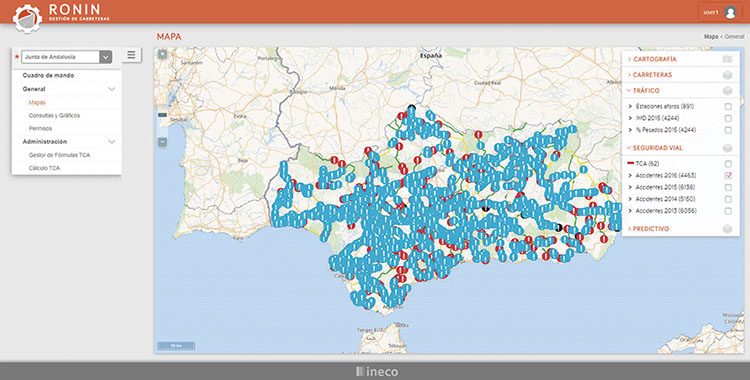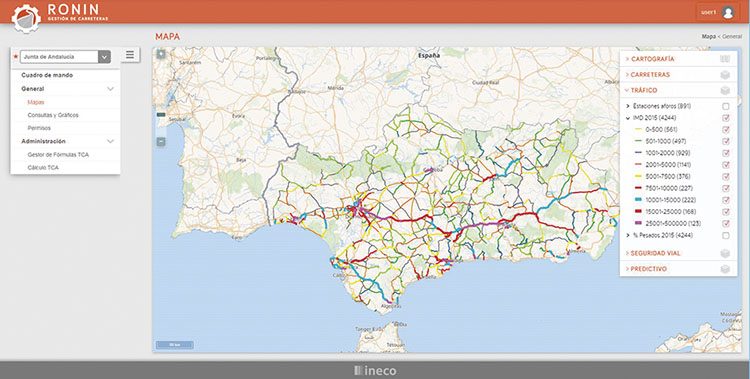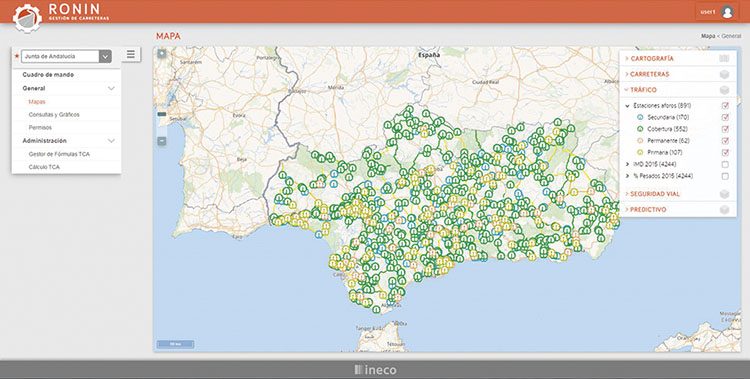Ineco’s RONIN innovation project was one of the three nominees for the 2019 Ponle Freno Awards, selected from among 105 proposals entered in the AXA Road Safety Innovation and Development category. This category recognises innovative products or designs that represent new scientific/technological developments in the improvement of road safety and that show a high potential for industrial transfer, enabling them to be put to use for the benefit of road users and society in general. The Ponle Freno Awards are an initiative of Atresmedia and AXA and aim to recognise people, institutions and initiatives that contribute to promoting road safety and, consequently, help reduce the number of accidents on Spain’s roads.
Prior to this award, RONIN won first place for Sustainable Development Goal 9 Industry, Innovation and Infrastructure, for helping to reduce accidents and optimise the predictive maintenance of the road network. The prize was awarded by the Spanish Global Compact Network, the most important initiative for the sustainability of the private sector promoted by the United Nations and Rafael del Pino Foundation. This award is part of the go!SDG Awards, which highlight the role of business and social entities in Spain when it comes to using innovation to achieve the UN’s Sustainable Development Goals (SDGs). These are awards that highlight initiatives that are already underway and have proven results, and serve as an inspiration for the Spanish private sector as a whole, encouraging intersector collaboration and dialogue.

TEAM PHOTO. Josué García, Iván Hernández, Rafael Ibáñez and Alejandro Rodríguez, members of the Ineco team that developed RONIN, with Mª Sonia Álvarez and Manuel Francisco on the screen in the background.
Previously, in its prototype stage, the tool was a nominee at the 3rd edition of the Innovation in Road Infrastructure Awards organised by the Spanish Road Technology Platform at Innovacarretera 2017, in the category of best R&D project, among more than 50 proposals. Innovacarretera 2017 was the 4th edition of the biannual Road Infrastructure Sector Technology Demonstration Fair, an event that brings together public authorities and companies in the same field in an updated format of live demonstrations of innovative products and services with road infrastructure applications.
A powerful tool for road safety
RONIN, innovative software developed by Ineco, facilitates the making of strategic decisions in the field of infrastructure safety, serving as a powerful tool for public authorities and road operators, with a notable impact on users of one of the principal means of transport. The software –designed to manage the road network– includes accident prediction models based on the weather, date and traffic flow.
RONIN includes accident prediction models based on the weather, date and traffic flow
One of the main capabilities of the RONIN tool is the automatic calculation of accident black spots using formula management and black spot calculation parameterisation functionalities based on the Guidelines of the procedure for the management of accident black spots and State Road Network’s safety classification, which makes it possible for the different available calculation methods to be applied to comply with Royal Decree 345/2011 of 11 March, providing a major benefit to drivers, who can easily consult critical information about sections of road with high risk of accidents in real time. The system incorporates accident prediction models (random decision forests) based on the weather (connection with the AEMET API), date and traffic flow or any variable that can be provided through online services, which are used to reduce the accident rate while optimising road network maintenance, with the ability to integrate future road maintenance variables considered to be of great interest. As a result, the degree of accident risk is obtained, making it possible to rank the probability of an accident occurring on a road section in the short term (1, 2 or 3 days).
In terms of road maintenance and operation, the RONIN tool enables public authorities to optimise expenditure based on greater efficiency of use of the limited resources available to them, investing them in locations where a greater risk of accident has been identified. In addition, the programme is scalable, allowing the incorporation of other modules, such as assistance in the management of improvable elements and identification of sections with high potential for improvement, which allow for longer-term planning of road improvement programmes and expected rate of return (ERR), adapting them to new regulations and, ultimately, improving their safety.
Lastly, it is possible to manage the road inventory and generate reports in editable format.
What is RONIN based on?
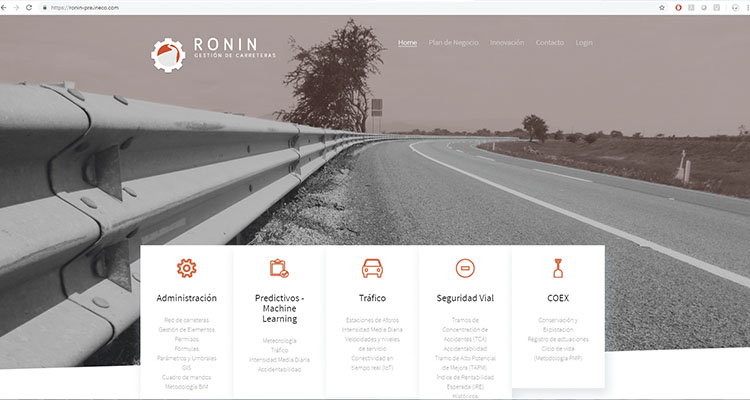
RONIN DASHBOARD. To supervise and monitor the road network, RONIN has an analysis system consisting of dashboards with key performance indicators (KPIs).
RONIN is a comprehensive road management web application that enables the efficient management of any road network over the course of its life cycle. The solution is based on a configurable and expandable inventory, in which all road elements are registered independently with their corresponding attributes, providing a fully scalable solution. The tool focuses mainly on road safety, specifically accident reduction, by facilitating early decision making through predictive models for infrastructure improvement, and is able to record, represent and analyse the different attributes that determine the safety of the network. Its main features are the following:
- Road manager
- Self-administration
- Road safety – accident black spots
- Parameterised formulation
- Accident prediction
- Real-time data
- Dashboard
- Web application – GIS
- Tracking over time
- Role-based safety
- Multi-language
- Customisable queries
- Predefined reports, in editable format
Features
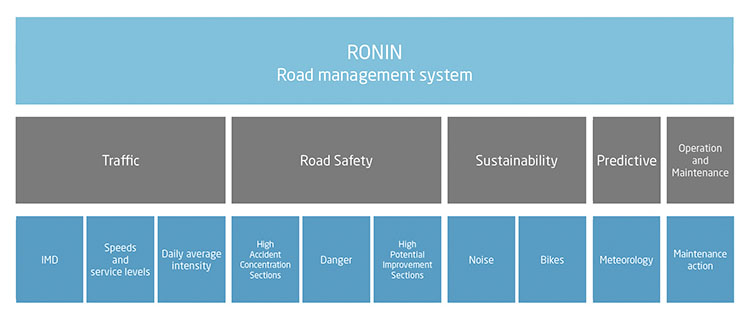
RONIN tool modules and features.
The tool’s many features include the monitoring and operation of traffic count plans, speed control and annual traffic levels of service . In the case of traffic counts, it includes a file for each count and its historical data; direct connection with count points; use of geographic information system (GIS) data and export to ETRS89 and WGS84 projection systems. Its most notable features are the following:
1. Traffic
• Traffic count stations
• Average daily intensity
• Speeds and service levels
• Real-time connectivity (IoT)
2. Road safety
• Accident black spots
• Accident rate
• Section with high potential for improvement
• Expected rate of return (ERR)
• Historical – Evolution – Comparative
3. Sustainability
• Bicycle capacity and noise analysis
4. Predictive – Machine Learning
• Meteorology, traffic, ADI – historical
• Proposal of standard actions
5. Maintenance and operation
• Record of actions (preventative and corrective)
• Life cycle (PMP methodology)
6. Administration
• Road network – administration, provincial services, maintenance and operation
• Elements – types – attributes
• Administration (user, road network, GIS layers, formulation, calculations, thresholds)
• Dashboard (customised by role)
• Export to Excel, Word, GIS
Traffic in Spain
Spain, with 80 million tourists each year, has a death rate of 39 per million inhabitants, the same as Germany, with 49 per million inhabitants being the average death rate in the EU. In 2018, according to data from the DGT, there were 102,299 traffic accidents with victims, in which 1,806 people died and 138,609 were injured, 8,935 of which required hospitalization. The Ineco team that developed RONIN used simulated data on the roads of Andalusia in its presentation. Different screenshots of the tool are shown below:



